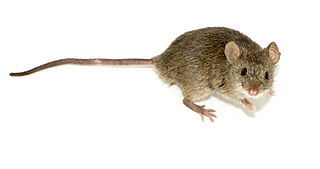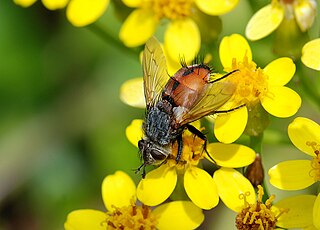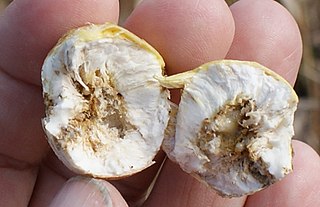
Carnivora is a diverse scrotiferan order that includes over 280 species of placental mammals. Its members are formally referred to as carnivorans, whereas the word "carnivore" can refer to any meat-eating organism. Carnivorans are the most diverse in size of any mammalian order, ranging from the least weasel, at as little as 25 g (0.88 oz) and 11 cm (4.3 in), to the polar bear, which can weigh up to 1,000 kg (2,200 lb), to the southern elephant seal, whose adult males weigh up to 5,000 kg (11,000 lb) and measure up to 6.7 m (22 ft) in length.

A house is a building that functions as a home. They can range from simple dwellings such as rudimentary huts of nomadic tribes and the improvised shacks in shantytowns to complex, fixed structures of wood, brick, concrete or other materials containing plumbing, ventilation, and electrical systems. Houses use a range of different roofing systems to keep precipitation such as rain from getting into the dwelling space. Houses may have doors or locks to secure the dwelling space and protect its inhabitants and contents from burglars or other trespassers. Most conventional modern houses in Western cultures will contain one or more bedrooms and bathrooms, a kitchen or cooking area, and a living room. A house may have a separate dining room, or the eating area may be integrated into another room. Some large houses in North America have a recreation room. In traditional agriculture-oriented societies, domestic animals such as chickens or larger livestock may share part of the house with humans. The social unit that lives in a house is known as a household.

The Lamiales are an order in the asterid group of dicotyledonous flowering plants. It includes about 23,810 species, 1,059 genera, and is divided into about 24 families. Well-known or economically important members of this order include lavender, lilac, olive, jasmine, the ash tree, teak, snapdragon, sesame, psyllium, garden sage, and a number of table herbs such as mint, basil, and rosemary.

Lizards are a widespread group of squamate reptiles, with over 6,000 species, ranging across all continents except Antarctica, as well as most oceanic island chains. The group is paraphyletic as it excludes the snakes and Amphisbaenia; some lizards are more closely related to these two excluded groups than they are to other lizards. Lizards range in size from chameleons and geckos a few centimeters long to the 3 meter long Komodo dragon.

A language family is a group of languages related through descent from a common ancestral language or parental language, called the proto-language of that family. The term "family" reflects the tree model of language origination in historical linguistics, which makes use of a metaphor comparing languages to people in a biological family tree, or in a subsequent modification, to species in a phylogenetic tree of evolutionary taxonomy. Linguists therefore describe the daughter languages within a language family as being genetically related.

A mouse, plural mice, is a small rodent characteristically having a pointed snout, small rounded ears, a body-length scaly tail and a high breeding rate. The best known mouse species is the common house mouse. It is also a popular pet. In some places, certain kinds of field mice are locally common. They are known to invade homes for food and shelter.

N is the fourteenth letter in the modern English alphabet and the ISO basic Latin alphabet.

In botany, a bulb is structurally a short stem with fleshy leaves or leaf bases that function as food storage organs during dormancy.

Sparrows are a family of small passerine birds. They are also known as true sparrows, or Old World sparrows, names also used for a particular genus of the family, Passer. They are distinct from both the American sparrows, in the family Passerellidae, and from a few other birds sharing their name, such as the Java sparrow of the family Estrildidae. Many species nest on buildings and the house and Eurasian tree sparrows, in particular, inhabit cities in large numbers, so sparrows are among the most familiar of all wild birds. They are primarily seed-eaters, though they also consume small insects. Some species scavenge for food around cities and, like gulls or rock doves will happily eat virtually anything in small quantities.

There is a wide variety of languages spoken throughout Asia, comprising different language families and some unrelated isolates. The major language families spoken on the continent include Altaic, Austroasiatic, Austronesian, Caucasian, Dravidian, Indo-Aryan, Indo-European, Afroasiatic, Siberian, Sino-Tibetan and Tai-Kadai. They usually have a long tradition of writing, but not always.

The shrew is a small mole-like mammal classified in the order Eulipotyphla. True shrews are not to be confused with treeshrews, otter shrews, elephant shrews, or the West Indies shrews, which belong to different families or orders.

The Thomisidae are a family of spiders, including about 175 genera and over 2,100 species. The common name crab spider is often linked to species in this family, but is also applied loosely to many other species of spiders. Among the Thomisidae, "crab spider" refers most often to the familiar species of "flower crab spiders", though not all members of the family are limited to ambush hunting in flowers.

Combtooth blennies are blenniiformids; percomorph marine fish of the family Blenniidae, part of the order Blenniiformes. They are the largest family of blennies with around 400 known species. Combtooth blennies are found in tropical and subtropical waters in the Atlantic, Pacific and Indian Oceans; some species are also found in brackish and even freshwater environments.

An asteroid family is a population of asteroids that share similar proper orbital elements, such as semimajor axis, eccentricity, and orbital inclination. The members of the families are thought to be fragments of past asteroid collisions. An asteroid family is a more specific term than asteroid group whose members, while sharing some broad orbital characteristics, may be otherwise unrelated to each other.

A small Solar System body (SSSB) is an object in the Solar System that is neither a planet, a dwarf planet, nor a natural satellite. The term was first defined in 2006 by the International Astronomical Union (IAU) as follows: "All other objects, except satellites, orbiting the Sun shall be referred to collectively as 'Small Solar System Bodies' ".

Feliformia is a suborder within the order Carnivora consisting of "cat-like" carnivorans, including cats, hyenas, mongooses, civets, and related taxa. Feliformia stands in contrast to the other suborder of Carnivora, Caniformia.

Toucans are members of the Neotropical near passerine bird family Ramphastidae. The Ramphastidae are most closely related to the American barbets. They are brightly marked and have large, often-colorful bills. The family includes five genera and over forty different species.

Freshwater snails are gastropod mollusks which live in freshwater. There are many different families. They are found throughout the world in various habitats, ranging from ephemeral pools to the largest lakes, and from small seeps and springs to major rivers. The great majority of freshwater gastropods have a shell, with very few exceptions. Some groups of snails that live in freshwater respire using gills, whereas other groups need to reach the surface to breathe air. In addition, some are amphibious and have both gills and a lung. Most feed on algae, but many are detritivors and some are filter feeders.

A grain is a small, hard, dry seed, with or without an attached hull or fruit layer, harvested for human or animal consumption. A grain crop is a grain-producing plant. The two main types of commercial grain crops are cereals and legumes.






















